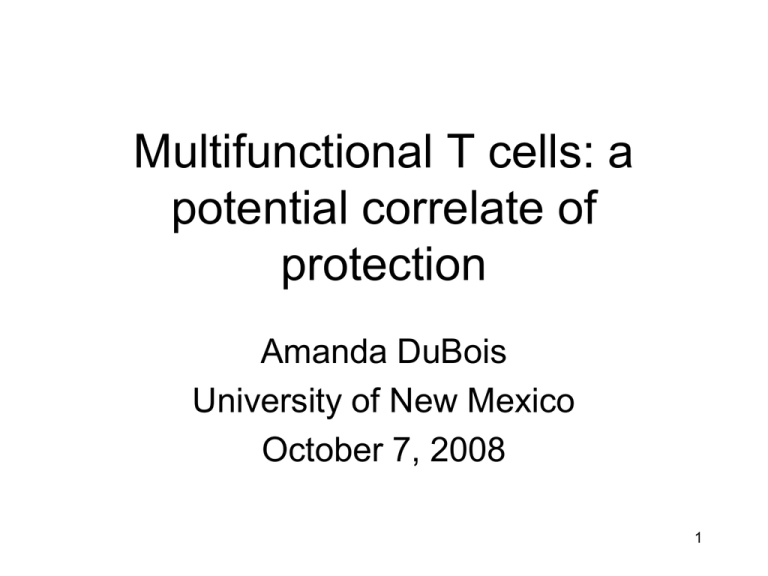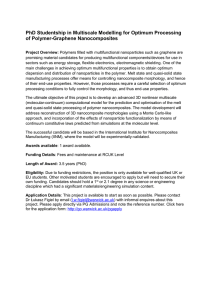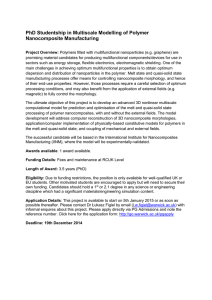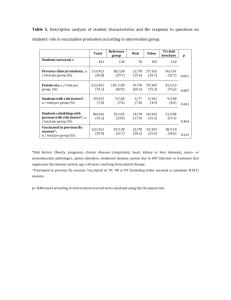Multifunctional T cells: a potential correlate of protection Amanda DuBois
advertisement

Multifunctional T cells: a potential correlate of protection Amanda DuBois University of New Mexico October 7, 2008 1 Background • Multifunctional T cells: CD4+ T cells that simultaneously produce IFN, TNF, and IL-2 • Degree of protection is predicted by the frequency of multifunctional T cells • Multifunctional T cells produced higher amounts of IFN 2 Lack of correlation between vaccine elicited protection against L. major and frequency of cytokine producing cells Weeks after challenge 3 Frequency of multifunctional TH1 cells correlates with protection +++ ++ + 4 Median fluorescence intensity for each cytokine indicates highest cytokine production by multifunctional T-cells 5 Multifunctional T cells are reduced in the spleen following intradermal infection with L. major 6 Milestone 21: UNM Protocol for multifunctional T cell assay • Harvest organs and process to single cell suspension • Treat cells – media – -CD28 – -CD28+HK LVS • Block secretion with Brefeldin A • Fix, permeabilize, and stain with antibodies to surface-expressed and intracellular proteins • Read on FACSCalibur (250,000 events) 7 Multiparameter flow approach IL-2-PE IFNγ-PE*Cy7 TNFα-A488 IL-2-PE TNFα-A488 TNFα-A488 8 IFNγ-PE*Cy7 IFNγ-PE*Cy7 IL-2-PE Effect of vaccination and Schu S4 challenge on quality of the T cell immune response • Naïve Balb/c • LVS I.N. vaccinated Balb/c (day 67 post-vacc) • LVS I.N. vaccinated/I.N. SchuS4 challenged (day 4 post-challenge) • Collected spleen and lung-associated lymph nodes (LALN) 9 Frequency of multifunctional T cells in the spleen are highest in vaccinated mice and decrease after SchuS4 challenge Naive LVS vaccinated HK-LVS αCD28 media HK-LVS αCD28 media HK-LVS αCD28 media Multifunctional Cells are the most abundant CD4+ population in the spleen of vaccinated mice but are equal in frequency to several other populations in the spleen of challenged mice SchuS4 challenged 10 Multifunctional T cells are producing the greatest amounts of each cytokine in the spleen of vaccinated mice IFNγ IL-2 TNFα 11 Frequency of multifunctional T cells are highest in lung-associated lymph nodes of mice challenged with SchuS4 Naive HK-LVS αCD28 media HK-LVS αCD28 media HK-LVS αCD28 media In the LN draining the site of infection, multifunctional T cells are the most abundant population, with slightly fewer cells producing TNFα and IFNγ but not IL-2 LVS SchuS4 vaccinated challenged 12 Multifunctional T cells are producing the greatest amounts of IFNγ and IL-2 in the LALN of SchuS4challenged mice IFNγ IL-2 TNFα 13 Summary of murine pilot studies • CD4+ cells simultaneously secreting IFN, TNF, and IL-2 were detected in the spleen of vaccinated mice and in the lung-associated LN of mice challenged intranasally with Schu S4 • These two populations of cells were responsible for the highest amounts of cytokine production in each environment • The frequency of multifunctional T cells decreased in the spleen and increased in the LALN following intranasal challenge as compared to vaccinated mice, indicating a migration of these cells from the systemic compartment to the site of infection 14 Non-human primate pilot study • Cynomolgus macaque vaccinated by intradermal inoculation with 1.5x107 cfu LVS on 11/20/06 • Inoculated by bronchoscope instillation with 1x105 cfu LVS on 6/25/08 • Day 12 after infection: lungs and spleen collected – Lungs and spleen cells analyzed for intracellular cytokine production – Extra cells frozen using Cerus freezing protocol 15 HK-LVS stimulated a high frequency of CD4+ lung cells producing TNF, IL-2, and IFN 16 Functionality profiles of CD4+ lung cells following stimulation with HK-LVS 17 Observations • Low frequency of CD4+ multifunctional cells in the media and α-CD28 treated cells • HK-LVS stimulated a high frequency of CD4+ multifunctional cells • Very little cytokine production by CD8+ cells that was not increased upon stimulation with HK-LVS 18 Summary of subsequent NHP experiments • Untreated NHP lung, spleen and LN cells do not respond to stimulation with HK-LVS • Frozen lung cells from LVS vaccinated/LVS challenged animal maintained responsiveness to stimulation with HK-LVS post-thawing, although the population profile was slightly different 19 Status of multifunctional assay • Mouse: – Developed assay to detect secretion of all three cytokines from CD4+ cells from lung, LALN, and spleen – Will also develop assay to detect cytokine-secretion by CD8+ cells in these tissues • Non-human primates: – Continuing to develop assay to detect secretion of all 3 cytokines from CD4+ and CD8+ cells isolated from the lungs, TBLN, and spleen of NHP • Development of assay using human peripheral blood mononuclear cells (PBMCs) in progress • Development of assay for use in rat model is planned • Have obtained commercially available cytokine positive cells to serve as positive control for each assay (human, mouse and rat available) 20 Questions to be addressed in mice • Is there a difference in the quality of the immune response induced in the respiratory or systemic compartments following LVS vaccination between protective and nonprotective mouse models? • Is there a difference in the magnitude or kinetics of recruitment of multifunctional cells following pulmonary F. tularensis infection between the protective and non-protective mouse models? 21 Questions to be addressed in nonhuman primates and humans • Is there a difference in the magnitude or kinetics of recruitment of multifunctional cells following pulmonary F. tularensis infection that can be correlated to differences in bacterial burden and dissemination between NHPs vaccinated via pulmonary versus parenteral delivery of LVS? • Can LVS vaccination induce detectable levels of F. tularensis-specific multifunctional cells in the blood of NHPs and humans and could the presence of these cells be used as correlate of protection for the development of human vaccines. 22




